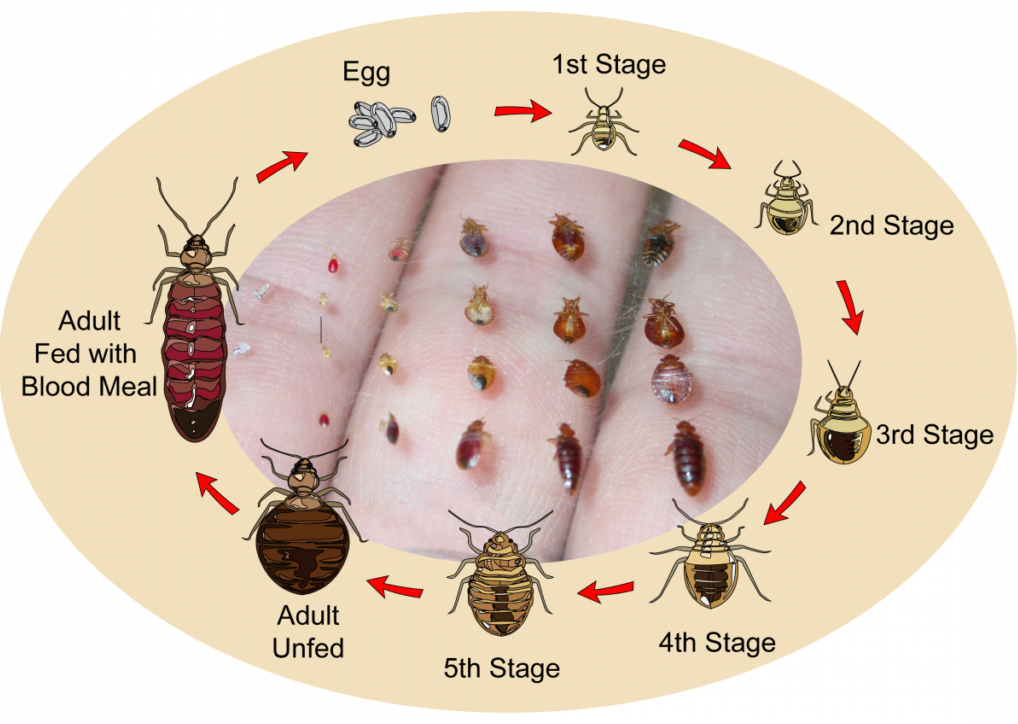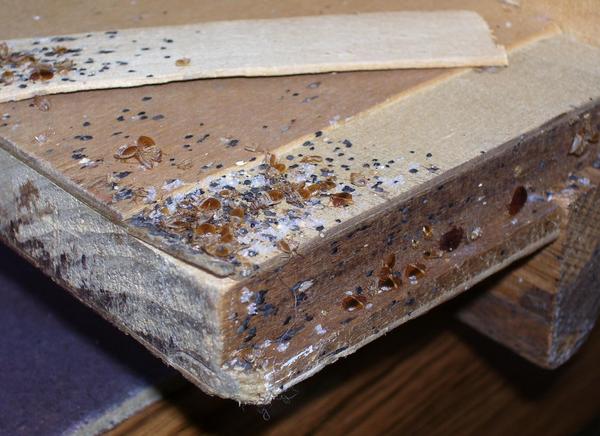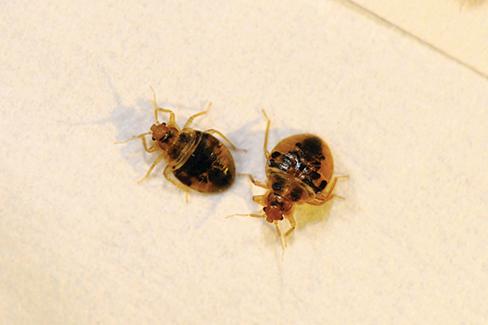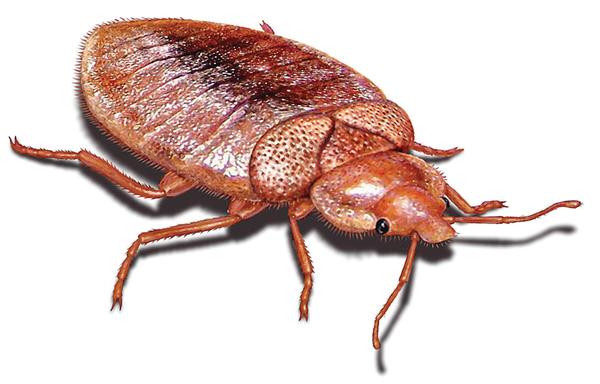Bed Bug Stage. Bed bugs, which feed on the blood of people and other warm-blooded animals, are nocturnal reddish-brown insects. These wingless insects can hide in floor cracks, carpets, mattresses, and upholstered furniture because to their dorsoventrally flattened bodies.
Being familiar with the bed bug life cycle may help you on your own or travel efforts to rid yourself or your family of bed bugs.
You should check your mattress and sheets for signs of these wingless, reddish-brown bugs when you suspect the presence of bed bugs at home or in a hotel room.
Bed bugs drop their outer shell during the bed bug life cycle, leaving behind telltale signs of a bed bug infestation.
Look for bed bug eggs as well as the bed bugs themselves, but be aware that bed bug sizes change throughout their lifecycle, depending on where they are in it.
About Bed Bugs
The Cimicidae (mostly Cimex lectularius) family of small parasitic bugs includes bedbugs. Cimex lectularius and Cimex hemipterus, both cosmopolitan or tropical and subtropical species, are connected with people.
Bedbugs are ectoparasitic blood suckers that feed on humans while they sleep and infest their beds. The adult bedbug feeds once a week under optimum conditions.
Human body temperature, as well as carbon dioxide generation and certain chemicals, appear to be the key attractants.
How Do Bed Bugs Reproduce?
Like with humans, bed bugs are sexual creatures. To reproduce, one female and one male bed bug must meet and mate.
The sex organ of male bed bugs is known as the aedeagus. This is situated at the very end of the abdomen. The male bed bug’s aedeagus will be used to enter the female bed bug below her abdomen when he seeks her out.
Bed bug copulation is known as “traumatic insemination” since the process damages the female’s exoskeleton.
After that, the male’s sperm will come into touch with the mesospermalege, which is a female sex organ. It then migrates to the female’s eggs in the ovaries, where it fertilizes them.
The female will lay her eggs three to six days later. She could put them all in her harborage (where she spends the most of her time) or she might put each one individually on her travels.

How Fast Are Bed Bugs Able to Breed?
It’s not the most enjoyable thing in the world to consider a bed bug population explosion. However, it’s always preferable to contain the population before it expands too much. This is an important factor to keep in mind. You may have a full-fledged infestation on your hands in just a few months.
After spending time at a hotel or another location where bed bugs were already present, most people bring them home. Without you even realizing it, one or more pests may have attached themselves to your attire or bags and returned home with you.
You may begin with just a few insects if you wish. Females, on the other hand, may lay one to five eggs every day. The eggs take around two weeks to hatch, and the initial stage nymphs will bite a host and drink blood as soon as they emerge.
Within two or three months, you could have a massive population on your hands if you wait five weeks for a 1st stage nymph to mature into an adult that can breed.
You may have tens of thousands of bed bugs around your home in just six months if no steps are taken to contain the infestation. Early detection is critical for this reason.
You should inspect your mattress thoroughly if you wake up with red bumps on your skin. Even though they are little, bed bugs may be seen. They have a flat appearance and are reddish brown in color.
Never wait until a bed bug problem becomes a concern to handle it; promptly acting is critical in controlling the spread of the insects.
bed bug stage
Blood is the sole source of food for bed bugs. They feed on sleeping humans at night because their blood meal takes around 5-10 minutes. Depending on the temperature, adult bed bugs can survive without feeding for up to a year.
In her lifetime, one female bed bug can produce up to 250 eggs. The nymph bed bug will go out to find its first blood meal in order to molt to the next stage after 6-10 days have passed since the eggs hatched.
Normally, each nymph stage lasts about a week (longer if a bed bug can’t locate a live host). Bed bugs are thought to live for 6 to 12 months in adulthood.

Eggs

An egg, grainy and milky white in color, is the first stage in a bed bug’s life cycle. Each day, female bed bugs lay one to five eggs, and over their lifetime, they may lay up to 500 eggs.
Eggs are placed in tight cracks or crevices and are laid singly or in clusters. The egg is comparable in size to two grains of salt, measuring around 1 mm in length. Bed bug eggs hatch in two weeks, and tiny bed bugs begin to feed right away.
Tight spots, where the eggs are unlikely to be found, are particularly popular.
Bedded frame or headboard joints and recesses.
Mattress wrinkles, such as those along the edges, are common.
Couchs, nightstands, dressers, wardrobes, and vanity units (particularly inside the wood joints or beneath) are examples of furniture with this characteristic.
Carpets and rugs, particularly in the corners of the room.
Wall and baseboard cracks, including the ones beneath chipped paint flakes.
Inside electrical outlets and light switches, as well as inside.
Small clusters of bed bug eggs are sometimes found, but they are usually found alone. Bed bugs place their eggs together with a gluey substance after they have been laid.
Eggs are so tiny that they could conceivably be anywhere, hence nowhere is safe. Eggs might be found in curtain folds, inside computer keyboards, or even on stuffed animals. They may be discovered on the backs of pictures hanging on the wall.
Bed bugs may spread anywhere that humans are present, so they might not all be in the bedroom.
What Do Bed Bug Eggs Look Like?
Bed bug eggs are difficult to detect with the naked eye, but they are visible if you look closely.
Bed bug eggs are around 1mm long on average. They’re like a piece of short-grain rice in the shape of an elongated oval.
The eggs of bed bugs are pale and partially transparent. A tiny black dot in one end may be visible if you look closely enough.
How Long Do Bed Bug Eggs Take to Hatch?
Under ideal circumstances, bed bugs spend around 6 to 9 days in the egg stage. Bed bug eggs thrive in temperatures of more than 70 degrees Fahrenheit for the quickest development.
It may take several extra days for the eggs to be ready to hatch if the temperature is lower.
How to Find Bed Bug Eggs
One strategy to keep your bed bug population in check is to locate and destroy bed bug eggs before they hatch.
You’ll need a magnifying glass, a strong flashlight, and a lot of luck if you’re going on a bed bug egg hunt.
Because of the size of bed bug eggs, they are often overlooked. They blend in nicely with any backdrop they’re put on since they’re somewhat translucent. Bed bugs also tend to deposit their eggs in the unlikeliest of areas, such as tiny crannies, making it difficult to detect them all.
You’ll have to check every room in your home until you find the one that matches.
You may be concerned how to tell if the eggs are live or have already hatched if you discover bed bug eggs. Here’s what to keep an eye on.
The eggs of live bed bugs are pale, spherical, and not withered or wrinkled.
Make sure the egg’s cap (tip) is still intact. The bug has already hatched if it’s gone or the egg has been opened.
This is an indication that the egg is practically ready to hatch if you can see two little red dots near the end. Bed bug eyes are represented by the dots.
Nymphs

Before reaching maturity, these juvenile bed bugs, known as nymphs, go through five molts. Nymphs are smaller in size and do not yet reach sexual maturity, despite their resemblance to adults.
Older nymphs and adults are reddish-brown in color, whereas young nymphs are yellow-white. Each nymph must receive a blood meal in order to complete a molting cycle. Nymphs change to adults in five weeks at room temperature.
What Does a Bed Bug Nymph Look Like?
Cream-colored baby bug nymphs emerge at a length of 1.5 to 2 mm. Their bodies are so thin that you can see through to their stomach contents, so once they’ve eaten, they appear bright red.
The nymphs grow gradually larger and darker in color as they go through each instar.
A bed bug nymph has the same body form as an adult bed bug, but it is smaller in size. They have a tiny thorax and a tiny head, which is joined by two antennae.
They have six legs and large, oval abdomens. Nymphs become more elongated and swollen after eating.
How Long Does Each Instar Last?
Two factors influence the length of each instar:
Nymphs can move, feed, and develop more quickly at optimum temperatures (above 70 but below 90 degrees Fahrenheit).
The availability of a human host is required. The nymph will begin looking for a human to feed on from the moment it hatches from the egg (or sheds its skin). Unless it has taken a blood meal, it can’t grow, molt, or progress to the next instar.
The nymph will take around 5 days to shed its skin after it has been fed. Each phase might only last 5 days if the nymph can feed within 24 hours of molting. Low temperatures and a lack of food, on the other hand, may halt progress.
The whole nymph stage, from hatching to becoming an adult, may take 35 to 40 days if the optimum conditions are met.
Adults
Bed bug adults make weekly feedings after reaching maturity.

A bed bug nymph will take one more blood meal and then molt again after reaching the fifth instar. It becomes an adult when it crawls out of its skin.
The exoskeleton of a bed bug will no longer peel once it reaches maturity. Nevertheless, for the rest of its existence, it will continue to feed on human blood.
A blood meal is sought about once every 3-7 days by adult bed bugs. The ambient temperature in the house, on the other hand, has an impact.
Bed bugs feed more frequently, about once every 2.5 days, when the temperature is warmer (78 degrees Fahrenheit), according to a study published in Medical and Veterinary Entomology.
They may only eat every 10 days or even less at colder temperatures.
Adult bed bugs perform two additional functions in addition to drinking blood: mating and producing eggs. Female bed bugs lay eggs, of course. Males mate as many times as they can with any female.
What Do Adult Bed Bugs Look Like?
Apple seeds are a good mimic for adult bed bugs. They range in length from 4.5 to 7 mm, which is about the same size. They’re a deep mahogany brown with red highlights, much like apple seeds.
Adult bed bugs have six legs, two tiny antennae, and an oval-shaped abdomen, much like their younger counterparts.
When seen from above, their bodies are obviously segmented. Other similar-looking bugs, such as spider beetles and carpet beetles, may be distinguished by this.
Since they are the biggest and darkest in color, adults are the most difficult to overlook. Nonetheless, especially during the day, they prefer to remain hidden in corners and alleys around the house. Bed bugs will come out at night to feed on you.
How Often Do Bed Bugs Feed?
Bed bugs that are adults only need to feed once a week. As a result, you may or may not have red bumps on your face every morning, depending on the size of the population you’re studying.
The pests, however, may go without eating for extended periods of time. Bed bugs may survive up to a year of eating, according to mythology, although this is unusual and seldom occurs. Bugs may go without eating for up to a month or two depending on the climate.
Bed bugs will still be waiting for you when you return even if you go away for a week or more for vacation.
It takes around five to ten minutes for a bed bug to get full during feeding when it bites your skin.
Bed bugs are tiny, and you may not notice when they bite you since the bite is so minuscule. When you wake up with red bumps on your skin, you may only realize something is wrong.
Although these bumps may itch, they pose little to no significant health risks unless you are allergic to bed bugs. Most people find the bites to be a minor bother, so they simply overlook them.
You should, however, perform a thorough examination of your mattress and furniture right away so that you may detect any bed bugs and resolve the problem. Getting rid of them may be difficult, but dealing with it when it’s still small will save you time and money.
How Long Do Bed Bugs Survive?
There’s one question on your mind right now: how long do bed bugs live for? Once you’re familiar with the life cycle of the bed bug, that’ll be an obvious answer.
This isn’t as simple a matter as it seems. The life cycle of a mature bed bug varies depending on numerous factors.
Temperature.
The availability of a host for feeding.
The prevalence of insecticides in the ecosystem.
A bed bug’s lifespan might be shortened by a number of factors, in addition to the aforementioned ones. For instance, if you roll over while sleeping and crush a bed bug to death, you might do it by accident. If the female is mated with too many times or the wound doesn’t heal properly, traumatic insemination may also result in her death.
Adult bed bugs have been discovered to survive up to 300 days in laboratory experiments, which is almost 10 months.
In laboratory experiments, bed bugs are cultivated in optimum circumstances. They are provided with as much blood as they desire, and their environmental temperature is carefully regulated.
So, in typical circumstances, let’s examine the variables that may influence bed bugs’ lifespan and how they might impact them.
Can Bed Bugs Lay Eggs Without Mating?

Several species of insects, for example, can lay eggs without mating.
The female of the species might lay eggs without being fertilized by a male in asexual reproduction. This allows you to reproduce quickly and easily without the assistance of a partner of the opposite sex.
Bed bugs are said to be able to reproduce asexually in certain literature. This is a misconception, which is fortunate for us. Despite the fact that asexual reproduction is required for bed bug survival, they have yet to develop it. Female bed bugs must mate with male bed bugs in order to lay eggs. Bed bugs are sexually reproducing insects.
Bed bugs, on the other hand, do not start to lay eggs for up to six days following mating. This implies that before laying her eggs, a pregnant female bed bug may migrate from one location to another, including an entirely new house.
Even if you only discovered one bed bug in your house, you might be at risk.
How Long Do Bed Bugs Live Without Feeding?
Many laboratory investigations have been done to determine how long bed bugs can go without feeding.
According to one research, adult bed bugs may live between 41.5 and 142.6 days (1.4 months and 4.7 months) in the laboratory of Virginia Tech’s Department of Entomology. That’s a rather lengthy period of time.
Bed bugs are thought to enter a dormant state when hungry, which would allow them to live for much longer since they use less of their bodily resources.
However, nymphs are a different story. Before being able to molt and progress to the next instar, a bed bug nymph must obtain at least one blood meal. The bed bug life cycle functions the same way as the traditional cycle does – it simply takes a lot longer.
Nymphs (up to and including the fourth instar) were able to survive between 13.6 and 131.9 days without food, according to the same study. The quicker they died without food, the younger the nymph.
Different studies typically produce varying results. Bed bugs have been known to live for more than a year without eating, according to certain research. Different strains of bed bugs from various locales might explain this, or it may be due to variable laboratory conditions.
It’s obvious that attempting to “starve out” bed bugs isn’t a feasible option unless you’re willing to live in a hotel for a year.